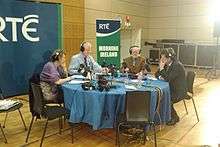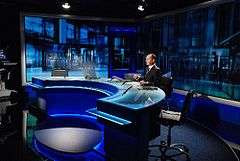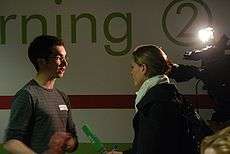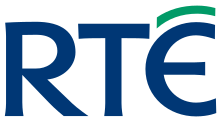RTÉ News and Current Affairs
RTÉ News and Current Affairs (Irish: Nuacht agus Cúrsaí Reatha RTÉ), is the national news service provided by Irish public broadcaster Raidió Teilifís Éireann. Its services include local, national, European and international news, investigative journalism and current affairs programming for RTÉ television, radio, online, podcasts, on-demand and for independent Irish language public broadcaster TG4. It is the largest and most popular news source in Ireland – with 77% of the Irish public regarding it as their main source of both Irish and international news.[2] It broadcasts in English, Irish and Irish Sign Language. The organisation is also a source of commentary on current affairs. The division is based at the RTÉ Television Centre in Donnybrook, Dublin; however, the station also operates regional bureaux across Ireland and the world.
| Independent Business Division (IBD) of RTÉ | |
| Industry | Media |
| Headquarters | , |
Area served | Specific services for Ireland including Northern Ireland |
Key people | Jon Williams (managing director)[1] |
| Services | Radio and television broadcasts |
| Owner | RTÉ |
| Website | rte |
History
Early history
On 1 January 1926, 2RN, Ireland's first radio station, began broadcasting. Its first advertised news bulletin was put out on 24 May 1926. Nine months later, on 26 February 1927, the station broadcast its first daily news report.[3]
During the Second World War, referred to in Ireland as The Emergency, media censorship of radio broadcasts (under the provisions of the Emergency Powers Act 1939) affected news bulletins. Before any news bulletin was broadcast, the script of the bulletin was read over the phone to Head of the Government Information Bureau, Frank Gallagher. Censorship under the Act was lifted on 11 May 1945.[4]
1960s
On 31 December 1961 Ireland's first national television station, Telefís Éireann, was officially launched. A new Television Complex was built at Donnybrook in Dublin and the news service was the first to move in. Charles Mitchel read the first television news bulletin, at 6:00 pm on 1 January 1962. Andy O'Mahony was the station's other chief newsreader in the early days of the new service. The new studios were still being completed, so construction work was heard during news bulletins.[5] Later on Telefís Éireann's first full day of broadcasting Broadsheet made its debut. This programme provided a more detailed analysis of topical matters and current affairs. There was a mixture of incisive and light-hearted items, unscripted studio interviews and filmed reports. Presented by John O'Donoghue, Brian Cleeve and Brian Farrell, some of these men would continue broadcasting with the station until the new century. Telefís Éireann's first full day also saw the first broadcast of the Nine O'Clock News, a half-hour bulletin including news, newsview, weather, and sports results.
Broadsheet was broadcast for the last time in 1964. It was replaced by Frank Hall's Newsbeat, a news and current affairs programme that focused more on the light-hearted stories from around the country.
In 1966 Maurice O'Doherty joined the newsroom as a newsreader. Later that same year the station's new flagship news programme was broadcast for the first time. Seven Days had a production team with people such as Eoghan Harris, Brian Cleeve, Brian Farrell, and John O'Donoghue. In 1967 the programme merged with another, Division, and became 7 days.[6]
1970s & 1980s

When Radio Éireann and Telefís Éireann merged, RTÉ News was expanded, providing coverage to new stations RTÉ Raidió na Gaeltachta and RTÉ Radio 2.[7]
In the 1970s News moved from the original Black and White picture format to color on television.
In the early 1980s, in the space of two years, there were three general elections. This demanded a larger schedule of current affairs. New programmes Morning Ireland and Today Tonight were launched.[8]
The current set of TV News programmes began in 1988, as RTÉ re-aligned their programmes. Seán Duignan and Eileen Dunne were the first presenters of Six-One, which began in October 1988[9]
1990s & 2000s

In 1991, RTÉ News appointed its first legal affairs correspondent, Kieron Wood.[10] Also in the 1990s, the first Washington, D.C. correspondent Mark Little was appointed, and Teilifís na Gaeilge, RTÉ lyric fm and RTÉ.ie were established.[11] In 1992 RTÉ launched its flagship current affairs programme Prime Time replacing Today Tonight. Other notable current affairs programmes from the 1990s include The Week in Politics & Oireachtas Report. Ed Mulhall became managing editor in the Newsroom Division in 1994, and was appointed managing director of RTÉ News and Current Affairs in 1997.[12]
Much of RTÉ's News output remained the same throughout the start of the 21st Century. In 2003 RTÉ's news department was merged with its Current Affairs department to form RTÉ News and Current Affairs. Also in September 2003, all RTÉ news reports in English on all networks were rebranded to RTÉ News, ending the separate branding of News 2 and 2FM News.[13] In December 2008, RTÉ News moved out of their usual studio 3[14] in the Television Centre at Donnybrook and moved into a temporary studio while work was carried out in studio 3 for the relaunch. The new look was unveiled at the One O'Clock news programme on Monday 9 February 2009.[15] Due to RTÉ cutbacks, instead of using satellite, reporters on foreign assignments were asked to send reports by internet link. RTÉ's Beijing bureau was closed in June 2009.[16] 2009 brought major changes the current affairs schedule with the axing of the long-running Questions and Answers which was replaced by The Frontline.
2010s
The 2010s opened with what has since been commemorated as "one of the most memorable moments of Irish television" being shown on RTÉ's televised news bulletins; amid a deep freeze on 8 January 2010, RTÉ showed one male individual slipping and sliding down the street in Dublin.[17]
On 3 April 2012, it was announced that Ed Mulhall had quit RTÉ News and Current Affairs.[18]
On 24 October 2012, RTÉ News & Current Affairs announced some major changes to its output from 2013.[19] Prime Time relaunched with a larger studio and additional presenters Claire Byrne and George Lee. The Frontline was also brought under the Prime Time brand with the programme now airing 3 times a week. In 2012, RTÉ announced it was moving some of its regional newsrooms to local Institute of Technology as a cost saving arrangement. The affected areas are Sligo, Dundalk, Galway, Athlone and Waterford. RTÉ will retain the Cork and Limerick bureaux.[20]
In January 2013, RTÉ launched a morning news programme, Morning Edition, which aired weekdays between 09:00–11:00 on RTÉ One and RTÉ News Now.[21] Morning Edition was cancelled in November 2014.[22] The Week in Politics now airs twice every Sunday premiering live at 12:00 and repeated again at its usual late-night slot. Morning Ireland relaunched in 2013 in a new studio and continues to air both on RTÉ Radio 1 and RTÉ News Now. RTÉ News will continue its interactivity with a revamped news app service for smartphones, tablets and wireless live news feed.
RTÉ News and Current Affairs currently produces over 1,000 hours of television programming and 2,000 hours of radio programming a year.[2]
On 26 April 2014, RTÉ News got a new look for all of its news programmes across RTÉ Television, with a tweaked logo, new opening & closing titles, new graphics, new backdrop in Studio 3 and a new arrangement of the 9 February 2009 news music. The new look was unveiled at the Six One news bulletin.[23]
On 22 September 2014, RTÉ News on Two was dropped. It was replaced two new early evening bulletins called News Feed at 18:55 and 19:55. In January 2017 News Feed was also dropped. RTÉ2 does not provide any news service outside the children's programme News2Day.
On 12 January 2015, RTÉ dropped the Monday night edition of Prime Time replaced by Claire Byrne Live.
In the summer of 2018, RTÉ announced their plan to refurbish and overhaul their news output in early 2019. RTÉ confirmed that they would be putting out to tender a contract worth close to €1.7 million to refurbish and renovate their news studio "Studio 3" at RTÉ Television Centre in Dublin. The overhaul will see the studio being redesigned, with a smaller news desk area and a larger second presentation area, along with new lighting, graphics, music and presentation.[24][25]
On 15 December 2018, RTÉ News moved out of Studio 3 into a temporary studio (Studio 2) at the television center. Work then commenced on refurbishing and overhauling Studio 3.
The refurbished Studio 3 of RTÉ was relaunched on 28 January 2019. Jon Williams, RTÉ News & Current Affairs Managing Director, said: "The new studio and design builds on the themes that have made RTÉ Ireland’s number one choice for TV News – bringing our audiences stories from across the world and around the corner.I’m particularly thrilled that "O’Donnell Abú" will again herald the news of the day – and grateful to the RTÉ National Symphony Orchestra for their interpretation of an iconic piece of music. The star of the news is the news – and I'm delighted that the audiences to RTÉ News will reap a dividend from last year's land sale."[26]
Programming

RTÉ News and Current Affairs is responsible for all the news bulletins on RTÉ One, TG4, RTÉ Radio 1, RTÉ 2fm, RTÉ lyric fm, RTÉ News Now, RTÉ Raidió na Gaeltachta, and RTÉ Europe. The division also provides written news updates on RTÉ's teletext service, Aertel, RTÉ Mobile and RTÉ.ie.[27] General news bulletins on TV and radio are usually branded as RTÉ News.
RTÉ News faces competition from within Ireland and abroad. For local news Virgin Media News provides competition in the television sector; as do Newstalk, Today FM and 4fm in the radio sector. As Ireland is a predominantly English-speaking nation, international news channels (CNBC Europe, CNN International, EuroNews, France 24, BBC News, Sky News, etc.) compete with RTÉ with regards television news coverage of international events. Despite this competition, however, RTÉ News remains the most popular source of news in Ireland.
Television programmes
RTÉ News and Current Affairs television programmes include:
- English-language
|
|
- Special News Programmes
The department also broadcasts numerous special programmes throughout the year. RTÉ has comprehensively covered every general & local election in Ireland since it was established. RTÉ has also covered some international elections such as elections for the Northern Ireland Assembly and Westminster as well as the US Presidential Election. Each year the Budget is covered with the budget delivery & analysis given on RTÉ One with RTÉ Two covering the live budget debate from Dáil Éireann. On occasion RTÉ may also provide rolling news coverage on an important developing news story such as on 9/11, the London Bombings of 2005 & events in Ireland such as the Dublin riots of 2006. Schedules are usually interrupted on RTÉ One to provide details of breaking stories.
- Irish-language
On RTÉ One
On TG4
- Nuacht TG4
- Timpeall na Tíre
- 7 Lá
- Irish Sign Language
- RTÉ News with Signing
- Cinnlinte Nuachta until 2009.
- Weather forecasts
Weather forecasts are provided by Met Éireann developed and presented largely by a team of meteorologists and specially trained weather presenters. The first televised weather forecast occurred on December 31, 1961.
RTÉ Weather provides regional, national, European and world weather reports. Special weather reports occur during significant weather events and specialist reports during the European ski season and reports for warmer climates during the winter season. Weather reports are in Irish, Irish Sign Language, and English.
Weather reports are also supplied for radio, online and on the RTÉ Player.
Radio

RTÉ News and Current Affairs radio programmes include:
- English-language
- Morning Ireland
- RTÉ News at One
- Drivetime
- World Report
- This Week
- News bulletins on the hour on RTÉ Radio 1 and RTÉ 2fm.
- News bulletins on the half-hour on RTÉ Lyric fm.
- Irish-language
- Adhmhaidin
- Nuacht a hAon
- Nuacht a Sé
- Regular Irish-language news bulletins on RTÉ Radio 1, RTÉ 2fm and RTÉ Raidió na Gaeltachta.
Online
Launched in May 1996; RTÉ News content is also available worldwide on the internet at rté.ie/news. The website provides news content in visual, audio and written formats. Users have the opportunity to stream previous news broadcasts from both TV and radio. Archived material is available through RTÉ Archive. Content is also made available through social media such as Facebook, Instagram, and Twitter. RTÉ News also produces an app which features breaking news content among other news content.
RTÉ News Now
Since 12 June 2008, RTÉ News has been served by RTÉ News Now. The channel airs commercial-free 24 hours a day with the latest live news. The station was initially made available on mobile phones and online at rte.ie/news. The channel broadcast in the Irish, English and ISL languages. The channel is also available on Saorview (channel 6), Sky channel 578 eir channel 200 virgin media channel 200, mobile phone service providers such as O2 Ireland, Vodafone Ireland and Android. The channel also provides a free service to users of iPhone, iPod touch and iPad. The channel was available on train services within Dublin city and surrounding regions under a special agreement between Irish Rail, Transvision and RTÉ.[29] Previously, Sky News provided such a service.
Bureaux
RTÉ have studios and offices in the following locations:[30]
- Regional
- Athlone
- Baile na nGall
- Belfast
- Castlebar
- Cork
- Derry
- Dublin
- Dundalk
- Galway
- Letterkenny
- Limerick
- Sligo
- Waterford
- International
Controversies
In March 2009, RTÉ was involved in controversy over a report about the placing of naked paintings of Taoiseach Brian Cowen in two Dublin Art Galleries. Initially, the station carried a television news report that displayed the pictures and treated the topic in a humorous light. However, after complaints from within the governing Fianna Fáil party, the station aired an apology to the Taoiseach.[31]
In May 2011, RTÉ broadcast on a Prime Time Investigates programme allegations that the Roman Catholic Priest Kevin Reynolds raped and impregnated a Kenyan teenager. A scandal ensued when the allegations were discovered to be false, which generated intensive media coverage and political debate in Ireland, resulting in a government inquiry into the broadcaster.[32][33]
References
- "RTÉ appoints Jon Williams as head of news". RTÉ News. 11 November 2016. Retrieved 27 March 2020.
- RTÉ News and Current Affairs
- "History of Irish Public Service Broadcasting – Timeline". RTÉ Libraries and Archives. 18 April 2006. Retrieved 9 June 2009.
- "Radio Éireann during the Emergency: 1939–45". History of RTÉ. Raidió Teilifís Éireann. 18 April 2006. Retrieved 19 July 2008.
- "MOVE TO MONTROSE: 10 DECEMBER 1961". RTÉ Libraries and Archives. 18 April 2006. Retrieved 9 June 2009.
- ""SEVEN DAYS" BEGINS". RTÉ Libraries and Archives. 18 April 2006. Retrieved 9 June 2009.
- "RTÉ Archives: 1970s". RTÉ Libraries and Archives. 18 April 2006. Retrieved 9 June 2009.
- "RTÉ Archives: 1980s". RTÉ Libraries and Archives. 18 April 2006. Retrieved 9 June 2009.
- Duignan, Seán (1 February 2012). "Politically incorrect". RTÉ Publishing. Retrieved 2 March 2012.
- "RTÉ Libraries and Archives". Raidió Teilifís Éireann. Retrieved 23 March 2011.
- "RTÉ Archives: 1990". RTÉ Libraries and Archives. 18 April 2006. Retrieved 9 June 2009.
- "Managing Director of News – Ed Mulhall". RTÉ News. 30 January 2007. Archived from the original on 18 August 2009.
- "RTÉ Press Releases 2003: New Look for RTÉ News". Raidió Teilifís Éireann. 1 September 2002. Archived from the original on 24 February 2007. Retrieved 30 June 2009.
- "RTÉ News comes from Studio 3, one of the smaller production facilities in Donnybrook". Alan Farquharson. Retrieved 30 June 2009.
- Grainne Cunningham (10 February 2009). "Here is the new-look news". Irish Independent. Retrieved 30 June 2009.
- Ronan McGreevy (13 June 2009). "The drama heats up at Montrose". The Irish Times. Retrieved 17 June 2009.
- O'Donoghue, Denise (8 January 2015). "The nation first saw this guy slipping on ice five years ago today". BreakingNews.ie. Archived from the original on 9 April 2015. Retrieved 8 January 2015.
- "RTE's head of news Ed Mulhall quits". Irish Independent. 3 April 2012. Retrieved 27 March 2020.
- "RTÉ shakes up News and Current Affairs". Hot Press. 24 October 2012.
- "RTÉ to move some regional operations to local institutes of technology". RTÉ News. 21 September 2012.
- "Keelin Shanley presents a new morning news programme for RTÉ". RTÉ Archives. 28 January 2013. Retrieved 27 March 2020.
- "Shock as RTE axes current affairs programme Morning Edition". Irish Independent. 5 November 2014. Retrieved 27 March 2020.
- "RTÉ News unveils new look tonight". RTÉ News. 26 April 2014.
- McDonagh, Darragh (4 June 2018). "RTE is going to make over its news studio this year for the first time in nearly a decade". TheJournal.ie.
- Horan, Rebecca (5 June 2018). "RTE to spend €1.7m on news studio makeover amid massive losses". Extra.ie.
- "RTÉ News unveils new studio for television bulletins". RTÉ News. 28 January 2019. Retrieved 27 March 2020.
- "Latest Breaking News Stories & Headlines". RTÉ News. Retrieved 30 June 2009.
- Orourke, Sean (17 May 2009). "My week: Sean O'Rourke". The Sunday Times. London. Retrieved 5 June 2009.
- "RTÉ News Now links up with Transvision". RTÉ News. 19 May 2010.
- "RTÉ Studios". Raidió Teilifís Éireann. 30 January 2007. Archived from the original on 24 July 2009. Retrieved 30 June 2009.
- Naked taoiseach paintings removed
- Irish TV Network Defames Innocent Priest, Issues Apology Archived 20 November 2011 at the Wayback Machine, The Media Report, November 2011, accessed 23 November 2011.
- Republic's government order probe into RTE Fr Reynolds libel case, BBC News, 23 November 2011.
